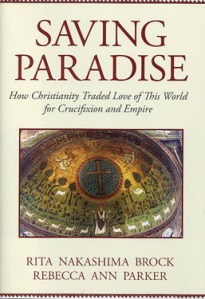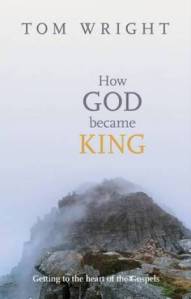 Saving Paradise is the theme book for Greenbelt 2012. It is provocative, thought-provoking, but ultimately flawed. Brock and Parker argue that the early Christian emphasis was not on crucifixion but on paradise, and paradise in the here-and-now. They subtitle the book: How Christianity Traded love of this world for crucifixion and Empire. I think that there is an important truth in this, that we need to hear, but unfortunately I think that the authors weaken their argument by over-stating their case and relying on problematic evidence.
Saving Paradise is the theme book for Greenbelt 2012. It is provocative, thought-provoking, but ultimately flawed. Brock and Parker argue that the early Christian emphasis was not on crucifixion but on paradise, and paradise in the here-and-now. They subtitle the book: How Christianity Traded love of this world for crucifixion and Empire. I think that there is an important truth in this, that we need to hear, but unfortunately I think that the authors weaken their argument by over-stating their case and relying on problematic evidence.
Saving Paradise (2009) argues that early Christianity focused not on the crucifixion of Jesus but on the power of the risen Jesus bringing paradise to the here and now. The book is about “seeking to understand the history of Christianity’s forgotten love for this world” (p415) They argue that eternal life starts now and that paradise was on earth as well as finally fulfilled in the new earth. In short Brock and Parker argue (p88):
Salvation in paradise was an experience and a place, as well as work yet to be completed.
I think that this is an important insight which needs to be heard by Western (evangelical?) Christians: we need to regain our focus on experience, on the importance of Creation, on the good things and the joy that this world can bring.
Brock and Parker note the importance of paradise to early theologians, with commentaries on Genesis 1-3 common. They also examine the iconography of Christian worship, which they argue did not include crucifixion scenes but sought to incorporate the worshippers into paradise. Churches included scenes of pastoral harmony, Christ the Good Shepherd, and welcomed worshippers as part of the sacred cosmos. Flowing on from this they argue that this understanding motivated the practical social concern that was one of the characteristics of early Christians. As they say (p99):
paradise was a reality that infused the church through works of love and rituals of sensual joy.
Brock and Parker then trace what they argue is the history of the suppression of this idea. So, for example, they contrast the actions of Ambrose calling the Emperor Theodosius to repentance (in AD 390) with the actions of Eusebius who welcomed Constantine (c.AD 324), based, they argue, on an emphasis as Christ as Victor who through war and violence brought victory. They also argue that the highly influential theologian Augustine also rejected the link between paradise and this world. Augustine’s book The City of God clearly distinguished between Rome and the city of God only embodied on Earth by the Church.
As part of this Brock and Parker argue that the rejection of Arianism was in part about asserting the churches authority over the Emperor. However, it is worth noting that, for example, Ambrose was heavily involved in arguing against Arianism, and sought to prevent the Emperor from taking over churches for the use of Arian worship.
Where I agree with Parker and Brock is in their argument that we have much to learn from early Christianity. So, for example, they contrast the individualistic understanding of Western society with the early Church’s understanding of humanity as socially enmeshed. They argue that individualism is inadequate to deal with the complex social realities of life and fails to deal with the complex problems confronting us. As they say (p130):
Paradise is not a private realm of personal spirituality – only communal practices and shared endeavors in ritually organized communities can open its gates.
They also have a thought-provoking take on worship. As I’ve mentioned above, they argue that there is a greater range of earthy, paradisal themes in worship iconography. They also argue that the earliest Eucharistic prayers such as that in the Didache and that discussed by Clement do not reference the crucifixion. Even in later prayers the crucifixion is listed as one of the important events but not the focus for worship or theology. They conclude (p166):
Rather than memorializing the execution of Christ, the Eucharist – as the images made clear – celebrated the incarnation and the everlasting life manifested in and through Christ.
Along with their critiques on the assimilation of Platonic and Roman ideals into Christian theology, and asides on topics like that fact that there were bans on ordination of women at Synods of Orange and Orleans (441 and 533 respectively) shows that women were being ordained, are interesting and helpful.
However, their over-statement of the case is encapsulated in two sentences describing an early church they visited in Turkey (p171):
There were no images of the Crucifixion anywhere.
However, the next paragraph starts:
In the center of the cross-shaped sanctuary…
Was it an accident that the building was cross-shaped or was it that the images of paradise were shaped by the cross? Does the lack of crucifixion imagery, both visual and textual, have more to do with the Roman taboo on talking about crucifixion than anything else?
This is part of Brock and Parker’s more comprehensive problem of privileging revisionist approaches over mainstream accounts. The list of authors that they rely on includes Elaine Pagel, Phylis Trible, John Dominic Crossan, Bahrt Ehrman, Daniel Boyarin, and A N Whitehead. None of these are accepted by most mainstream scholars, but this is not even mentioned by Brock and Parker. There is also a naive use of texts, both Biblical and non-biblical, so that they tend to be taken at face value. For example, they assume Josephus’ account of the siege of Masada is accurate despite modern scholarly critiques which note that this has more similarities with Roman stories of heroic final stands than reality. They also discuss Gnostic texts without critiquing non-Christian influences on them. Their interpretations of John’s Gospel as anti-semitic and Revelation as promoting violence are deeply contentious and arguable, but none of the alternative arguments are considered.
The positive and problematic elements of their arguments are both revealed in their concluding statements. They say (p409):
We can come to know the world as paradise when our hearts and souls are reborn through the arduous and tender task of living rightly with one another and the earth… It begins with love.
…Paradise is human life restored to its divinely infused dignity and capacity, and is a place of struggle with evil and injustice, requiring the development of wisdom, love, nonviolence, and responsible uses of power… Paradise is not a place free from suffering of conflict, but it is a place in which Spirit is present and love is possible.
They then go on to extol the importance of community. So, there is much which is important for us to be reminded of and challenged by. But, God has faded into the background, there is no mention of Jesus opening up the possibility of this paradise to us, and ‘Spirit’ is used impersonally. Also inamongst this passage is also a decidedly non-Biblical understanding of the realm of the dead: “Paradise is simultaneously this earth, a beautiful, luminous creation, and the realm of the dead, which is connected to the living but is separated by a thin veil through which the dead can pass to accompany, bless, or guide the living.”
 This is all in contrast with Tom Wright’s new book How God became King (2012), which I have also reviewed. This also explores the coming of God’s kingdom, brought to earth by Jesus. This again emphasises the importance of this world, how we live, and what we do but in a way that draws out the meaning and importance of the biblical witness and places the life, death and resurrection of Jesus at the heart of this understanding.
This is all in contrast with Tom Wright’s new book How God became King (2012), which I have also reviewed. This also explores the coming of God’s kingdom, brought to earth by Jesus. This again emphasises the importance of this world, how we live, and what we do but in a way that draws out the meaning and importance of the biblical witness and places the life, death and resurrection of Jesus at the heart of this understanding.



Fascinating insites Graham. I shan’t bother to read the book now but I might read the Tom Wright one. As ever, engaging and thought provoking. Thank you for posting this! :)
LikeLike
Thank you! Tom Wright’s book is definitely worth reading!
LikeLiked by 1 person
I appreciate your thoughts here. However, your point about the cross shaped sanctuary in Turkey is not a valid critique. The authors never say that crosses were not a part of the art and aesthetic of the early church. In fact, the cross is readily evident even on the cover of the book in the mosaic from St Appolinare Church in Ravenna. Their point has to do with the representation of suffering in the person of Jesus on the cross, not with the empty cross itself and its many possible interpretations it offers to those who view it.
LikeLike
Hi Rick,
thanks very much for your comment. I think that my critique still stands (although I will have another look at the book to check).
They argue that the focus (shown by the lack of images of the crucifixion) was on the incarnation and everlasting life of Christ. However, they don’t consider what it might mean to focus on the everlasting life of Christ (and his worshippers) in a building which was itself an image of the cross.
As you imply, I think it’s a matter of emphasis, rather than absolutes, but I think that they overstated the case; and this example was a way of demonstrating it!
I hope that makes it a bit clearer?
Thanks again,
from Graham
LikeLike